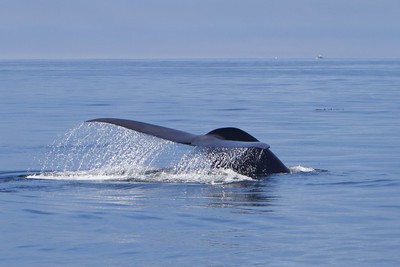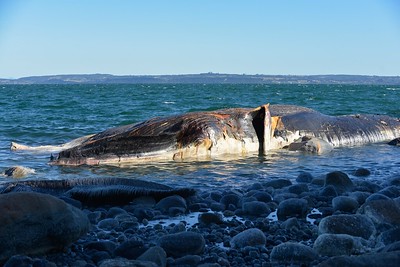Shark whales and blue whales are popular oceanic animals. Let us conduct a comparative analysis on them.
Shark whales are touted as the largest species of the fish family whereas blue whales are the largest living animals on Earth. While shark whales are stouter, blue whales have a leaner appearance. Besides, shark whales have a blunt snout as compared to the pointed cone-like snout of blue whales.
Key Takeways:
| Aspect | Whale Sharks | Blue Whales |
|---|---|---|
| Size | Grow up to 15-32 feet; 41,000 lbs (20 t) | Grow up to 70-80 feet; 200,000-300,000 lbs (100-150 t) |
| Appearance | Flattened head, blunt snout, bluish-gray | Pointed snout, deep-blue body, white underside, slender build |
| Habitat | Found in temperate and tropical seas | Found in oceans worldwide (except the Arctic) |
| Diet | Fish, plankton, shrimp | Krill |
| Feeding Mechanism | Gill rakers and small mouth | Baleen plates |
| Dietary Variety | Eats fish, plankton, and shrimp | Primarily krill, filter feeder |
| Biological Classification | Fish, with gills | Cetacean, a mammal with lungs |
Both shark whales and blue whales are bluish-gray in appearance but shark whales have pale stripes on its body whereas blue whales have a mottled body. Today, we will go through some of the most common questions people ask about these two creatures.

Image Credits: “Diving Maldives, 2009” by Christian Steen is licensed under CC BY 2.0

Image Credits: “Blue Whale” by mrmoorey is licensed under CC BY 2.0
Are shark whales and blue whales same?
Shark whales and blue whales are two of the most interesting aquatic animals. Let us learn more about them.
Shark whales and blue whales are essentially different animals but they have certain similarities. Both of them are filter feeders and massive creatures but blue whales are much larger and more powerful than shark whales. Moreover, blue whales are quick swimmers whereas shark whales are known to be slow-moving creatures.
Another common point of similarity between blue whales and shark whales is that both these creatures have a unique bluish-gray coloring with a mottled body.
What is the difference between shark whales and blue whales?

Image Credits: “Whale Shark” by Mike Johnston is licensed under CC BY 2.0
Besides appearance, there are several other points of differences between blue whales and shark whales. Let us explore more in this regard.
One of the major differences between whale sharks and blue whales is their biological classification. While whale sharks are identified as fishes and belong to the shark family, blue sharks are cetaceans and is classified as a mammal. Since whale sharks are fishes, they have gills which helps them breathe whereas like mammals, blue whales have lungs to breathe.
The differences between blue whales and shark whales are numerous, despite their relatively similar appearance.
Can whale sharks beat blue whales?
Shark whales and blue whales are both powerful in their own right. But, can shark whales beat blue whales? Let us find out together.
Whale sharks cannot beat blue whales. As some of you might already know, blue whales are the biggest known animals on this planet. Therefore, they can easily tackle any potential predator that might come in their path. Moreover, blue whales are fast swimmers and can easily avert any attack. Their only known predator are orcas also known as killer whales.
That being said, whale sharks are non-aggressive animas and remain docile as long as they don’t feel threatened. Therefore, they rarely pose a threat to blue whales or even humans.
Do blue whales eat sharks?
Blue whales are large animals with a very specific diet requirement. Let us find out if they eat whale sharks or sharks in general.
Blue whales are filter feeders meaning they eat by straining their food from water. As such, they do not prey on sharks or other large aquatic species like killer whales but prefer sticking to krill. Moreover, since they are baleen animals, they do not have teeth. Their baleen plates can merely sift the krill through water.
Since blue whales do not have teeth, they cannot bite into any potential prey. Therefore, they stick to feeding on krill.
Shark whales vs blue whales size
Shark whales and blue whales are huge animals, who can be extremely overpowering. Let us learn the difference between their sizes.
Whale sharks grow up to 15 to 32 feet and can generally weigh anywhere around 41,000 lbs or 20 tonnes (approx) whereas blue whales grow up to 70 to 80 feet and can weigh around 200,000 to 300,000 lbs (100 to 150 tonnes). Some whale sharks can grow up to 59 feet whereas blue whales may grow as tall as 110 feet.
There is a huge difference in size between the two animals. In fact, blue whales are the largest known animal species. Therefore, you can easily distinguish between them by closely looking at their appearance.
Shark whales vs blue whales appearance

Image Credits: “Blue Whale – Balleine Bleue” by Alan ✪ is licensed under CC BY 2.0
One of the unique aspects of blue whales and whale sharks is their distinguishing appearance. Let us learn more about them.
Whale sharks have a flattened head, blunt snout and bluish-gray appearance with a white underside whereas blue sharks have a pointed snout with a deep-blue colored body that gets lighter on the sides. Like whale sharks, they have a white underbelly. Besides, blue whales have a more slender body than shark whales.
Whale sharks and blue whales are enormous creatures who can easily be distinguished by their appearance. While whale sharks are stouter, blue sharks tend to be leaner.
Shark whales vs blue whales habitat
Shark whales and blue whales have different habitat requirements. Allow us to tell you more about them.
Whale sharks are usually found in temperate and tropical seas where the water is warmer and more comfortable whereas blue whales are found in oceans across the globe except the arctic region. Whale sharks can be found in 30°N to 35°S latitudes whereas blue whales are commonly found in 50°N to 50°S latitude.
One of the most common regions where shark whales are found is Australia whereas blue whales are often found in Pacific, Atlantic, and Indian Oceans.
Shark whales vs blue whales diet
Shark whales and blue whales have differing diet requirements. Let us learn more about them.
Whale sharks can eat fish, plankton, and shrimp whereas blue whales only feed on krill. We must mention here that shark whales have tiny teeth and a small mouth, no bigger than 4 feet, and as such, they use their gill rakers to capture the food. On the other hand, blue whales sift the krill from water using their baleen plates.
An interesting point is that both these animals are filter feeders. Therefore, they do not bite or capture their prey the way a traditional shark does.
Conclusion
Whale sharks and blue sharks are unique species who are known for their bright coloration, massive size, and varying diet requirements. These species help maintain the ecological balance in the aquatic system and helps clean out the ocean by removing krill, plankton, and other dead animals. However, over the years, they have been subjected to exploitation for commercial gains in the form of shark meat, oil, etc. As such, several steps have been taken by environmentalists to protect these animals.




